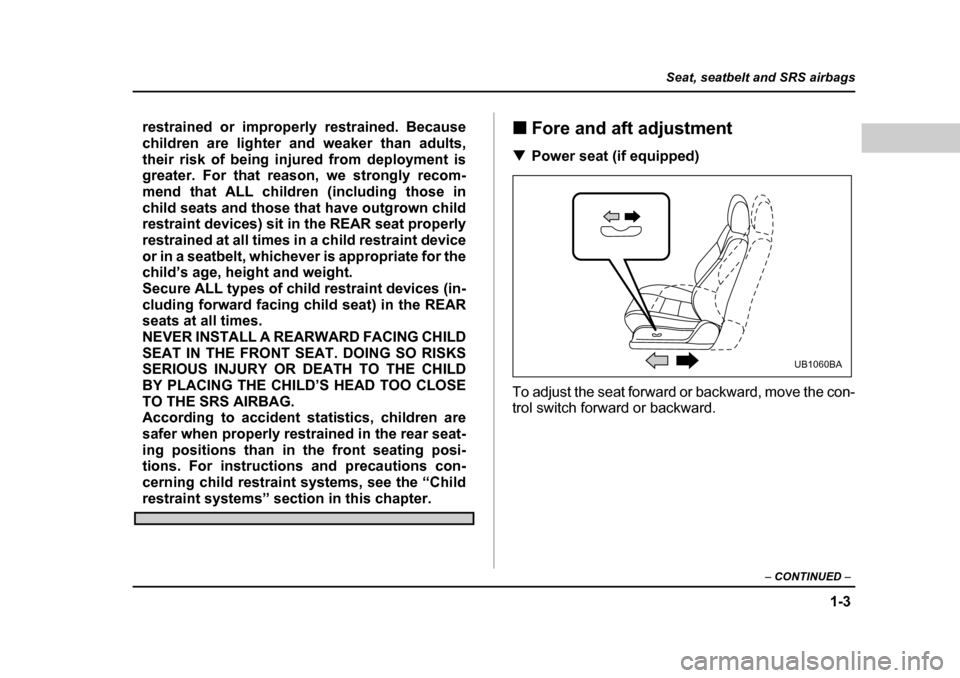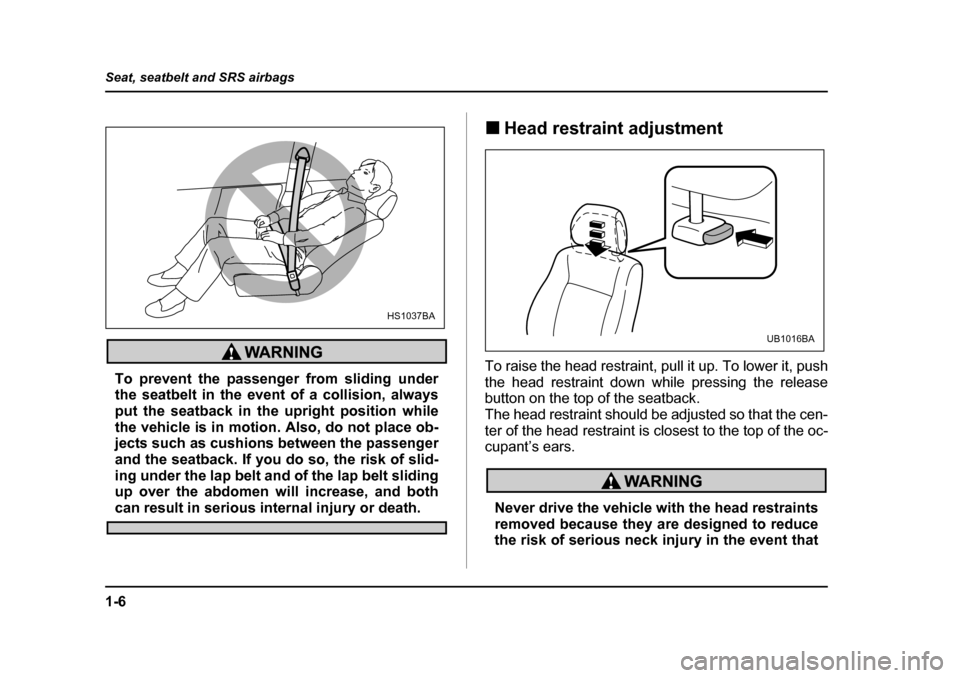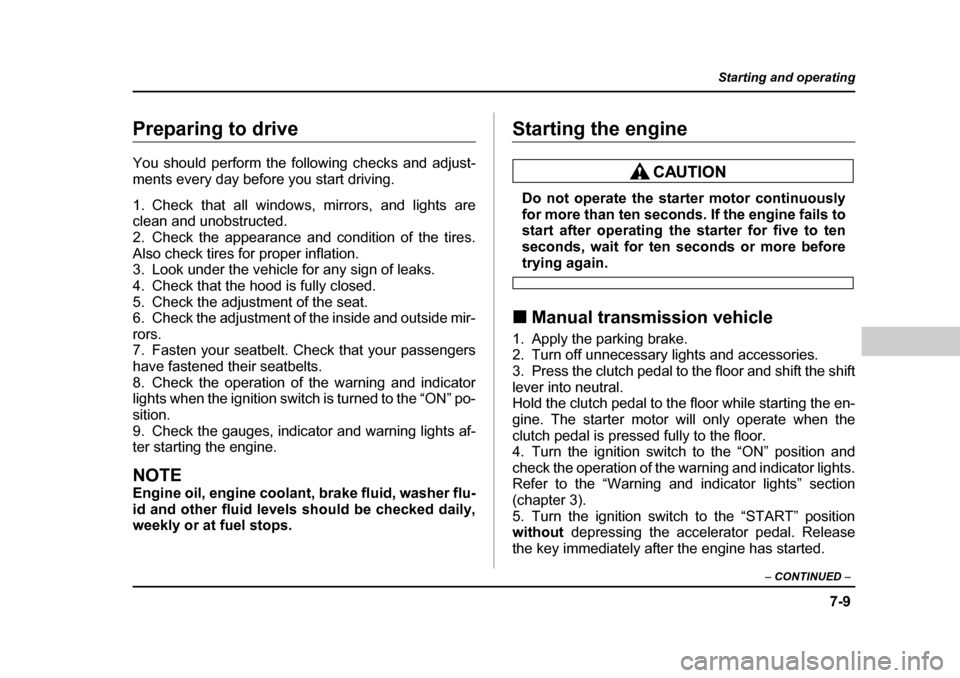2005 SUBARU BAJA seat adjustment
[x] Cancel search: seat adjustmentPage 26 of 469

1-1
1
Seat, seatbelt and SRS airbags
Front seats .................................................... 1-2 Fore and aft adjustment ................................... 1-3
Seat cushion angle and height adjustment (Power seat only) ........................................... 1-4
Reclining the seatback ..................................... 1-5
Head restraint adjustment ................................ 1-6
Lumbar support (if equipped) .......................... 1-7
Seat heater (if equipped) .............................. 1-7
Rear seats ..................................................... 1-9 Rear headrest .................................................... 1-9
Folding down the rear seat .............................. 1-10
Seatbelts ....................................................... 1-14 Seatbelt safety tips ........................................... 1-14
Emergency Locking Retractor (ELR) .............. 1-16
Automatic/Emergency Locking Retractor (A/ELR) ............................................................ 1-16
Seatbelt warning light and chime .................... 1-17
Fastening the seatbelt ...................................... 1-17
Seatbelt maintenance ....................................... 1-21
Seatbelt extender ......................................... 1-22
Front seatbelt pretensioners ....................... 1-24 System monitors ............................................... 1-25
System servicing .............................................. 1-26
Precautions against vehicle modification ...... 1-27
Child restraint systems ................................ 1-28 Where to place a child restraint system ......... 1-29
Choosing a child restraint system .................. 1-31
Installing child restraint systems with A/ELR seatbelt ............................................................ 1-32 Installation of child restraint systems by use
of lower and tether anchorages (LATCH) .... 1-40
Installing a booster seat ................................... 1-45
*SRS airbag (Supplemental Restraint System airbag) ........................................... 1-47Vehicle with driver’s and front passenger’s SRS airbags and lap/shoulder restraints ..... 1-47
SRS frontal airbag ............................................ 1-52
SRS airbag system monitors ........................... 1-60
SRS airbag system servicing .......................... 1-61
Precautions against vehicle modification ...... 1-62
Page 28 of 469

1-3
Seat, seatbelt and SRS airbags
– CONTINUED –
restrained or improperly restrained. Because
children are lighter and weaker than adults,
their risk of being injured from deployment is
greater. For that reason, we strongly recom-
mend that ALL children (including those in
child seats and those that have outgrown child
restraint devices) sit in the REAR seat properly
restrained at all times in a child restraint device
or in a seatbelt, whichever is appropriate for the
child’s age, height and weight.
Secure ALL types of child restraint devices (in-
cluding forward facing child seat) in the REAR
seats at all times.
NEVER INSTALL A REARWARD FACING CHILDSEAT IN THE FRONT SEAT. DOING SO RISKS
SERIOUS INJURY OR DEATH TO THE CHILD
BY PLACING THE CHILD’S HEAD TOO CLOSE
TO THE SRS AIRBAG.
According to accident statistics, children are
safer when properly restrained in the rear seat-
ing positions than in the front seating posi-
tions. For instructions and precautions con-
cerning child restraint systems, see the “Child
restraint systems” section in this chapter. �„
Fore and aft adjustment
�T Power seat (if equipped)
To adjust the seat forward or backward, move the con-
trol switch forward or backward.
UB1060BA
Page 31 of 469

1-6
Seat, seatbelt and SRS airbags
To prevent the passenger from sliding under
the seatbelt in the event of a collision, alwaysput the seatback in the upright position while
the vehicle is in motion. Also, do not place ob-
jects such as cushions between the passenger
and the seatback. If you do so, the risk of slid-
ing under the lap belt and of the lap belt sliding
up over the abdomen will increase, and both
can result in serious internal injury or death.
�„
Head restraint adjustment
To raise the head restraint, pull it up. To lower it, push
the head restraint down while pressing the release
button on the top of the seatback.
The head restraint should be adjusted so that the cen-
ter of the head restraint is closest to the top of the oc-
cupant’s ears.Never drive the vehicle with the head restraints
removed because they are designed to reduce
the risk of serious neck injury in the event that
HS1037BA
UB1016BA
Page 244 of 469

7-9
Starting and operating
– CONTINUED –
Preparing to drive
You should perform the following checks and adjust-
ments every day before you start driving.
1. Check that all windows, mirrors, and lights are
clean and unobstructed.
2. Check the appearance and condition of the tires.
Also check tires for proper inflation.
3. Look under the vehicle for any sign of leaks.
4. Check that the hood is fully closed.
5. Check the adjustment of the seat.
6. Check the adjustment of the inside and outside mir-
rors.
7. Fasten your seatbelt. Check that your passengers
have fastened their seatbelts.
8. Check the operation of the warning and indicator
lights when the ignition switch is turned to the “ON” po-sition.
9. Check the gauges, indicator and warning lights af-
ter starting the engine.
NOTE
Engine oil, engine coolant, brake fluid, washer flu-
id and other fluid levels should be checked daily,
weekly or at fuel stops.
Starting the engine
Do not operate the starter motor continuously
for more than ten seconds. If the engine fails to
start after operating the starter for five to ten
seconds, wait for ten seconds or more before
trying again.
�„ Manual transmission vehicle
1. Apply the parking brake.
2. Turn off unnecessary lights and accessories.
3. Press the clutch pedal to the floor and shift the shift
lever into neutral.
Hold the clutch pedal to the floor while starting the en-
gine. The starter motor will only operate when the
clutch pedal is pressed fully to the floor.
4. Turn the ignition switch to the “ON” position and
check the operation of the warning and indicator lights.
Refer to the “Warning and indicator lights” section(chapter 3).
5. Turn the ignition switch to the “START” position
without depressing the accelerator pedal. Release
the key immediately after the engine has started.
Page 462 of 469

14-5
Index
Gauge ............................................................. 3-8
Requirements ................................................. 7-2
Fuses ............................................................... 11-57
Fuses and circuits ............................................. 12-5 G
GAWR (Gross Axle Weight Rating) ................... 8-19
Glove box ............................................................ 6-5
GVWR (Gross Vehicle Weight Rating) .............. 8-19 H
Hazard warning flasher ....................................... 3-5
Head restraint adjustment (Front) ........................ 1-6
Headlight flasher ............................................... 3-19
Headlights .............................................. 3-18, 11-64
Heater operation .................................................. 4-7
High beam indicator light ................................... 3-16
High mount stop and cargo light assembly ...... 11-77
Horn ................................................................... 3-34
Hose and connections ..................................... 11-18 I
Ignition switch ...................................................... 3-2
Illuminated entry .................................................. 2-9
Illumination brightness control ........................... 3-21 Indicator light
High beam .................................................... 3-16
Selector lever position .................................. 3-15
Turn signal .................................................... 3-16
Inside mirror ...................................................... 3-28
Interior light .......................................................... 6-2 J
Jack and tools ..................................................... 9-3
Jump starting ..................................................... 9-18 K Key Interlock release ............................................. 3-4
Number ........................................................... 2-2
Reminder chime ............................................. 3-4
Keys .................................................................... 2-2 L
Leather seat materials ....................................... 10-6
License plate bracket ........................................ 2-26
License plate light ............................................ 11-74
Light control switch ............................................ 3-18
Limited slip differential (LSD) ............................ 7-31
Loading your vehicle ......................................... 8-16
Lower tether anchorages ................................... 1-40